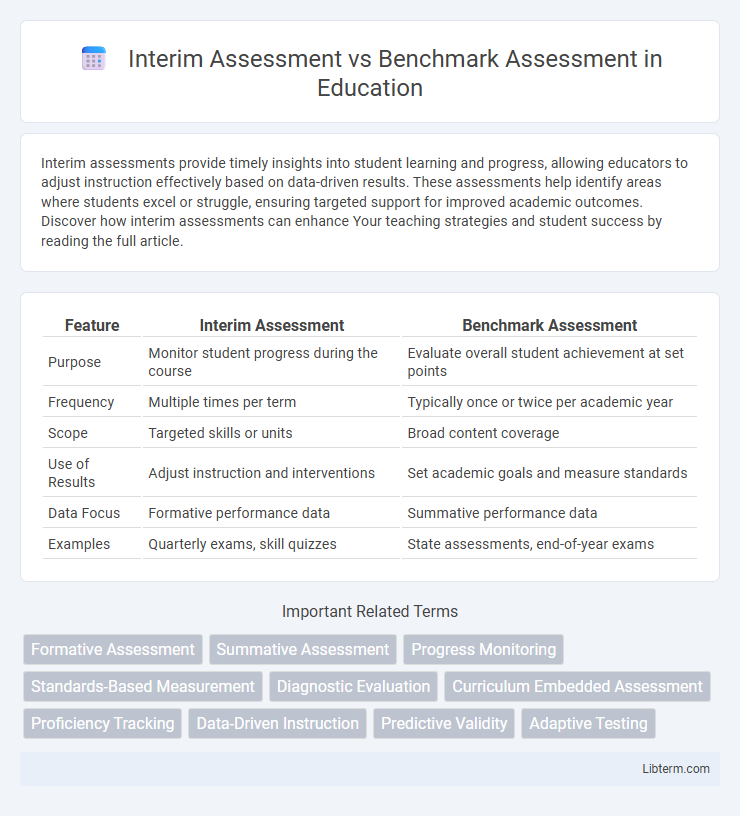Interim assessments provide timely insights into student learning and progress, allowing educators to adjust instruction effectively based on data-driven results. These assessments help identify areas where students excel or struggle, ensuring targeted support for improved academic outcomes. Discover how interim assessments can enhance Your teaching strategies and student success by reading the full article.
Table of Comparison
| Feature | Interim Assessment | Benchmark Assessment |
|---|---|---|
| Purpose | Monitor student progress during the course | Evaluate overall student achievement at set points |
| Frequency | Multiple times per term | Typically once or twice per academic year |
| Scope | Targeted skills or units | Broad content coverage |
| Use of Results | Adjust instruction and interventions | Set academic goals and measure standards |
| Data Focus | Formative performance data | Summative performance data |
| Examples | Quarterly exams, skill quizzes | State assessments, end-of-year exams |
Understanding Interim Assessments
Interim assessments provide timely insights into student learning progress throughout the academic year, allowing educators to adjust instruction and address learning gaps promptly. Unlike benchmark assessments, which are typically administered at fixed points to evaluate overall achievement against grade-level standards, interim assessments are flexible and can be scheduled multiple times to monitor ongoing performance. Understanding interim assessments is crucial for data-driven decision-making that enhances student outcomes by informing targeted interventions.
What Are Benchmark Assessments?
Benchmark assessments are standardized tests administered at designated points throughout the academic year to measure students' proficiency against established performance standards. These assessments provide comparative data that help educators identify learning gaps and adjust instruction to meet grade-level expectations. Commonly used across various subjects, benchmark assessments inform long-term educational planning and evaluate the effectiveness of curriculum implementation.
Key Differences Between Interim and Benchmark Assessments
Interim assessments are periodic evaluations administered throughout the academic year to monitor student progress and inform instruction, while benchmark assessments are more comprehensive tests designed to measure proficiency relative to grade-level standards at specific intervals. Interim assessments provide formative data for targeted interventions, whereas benchmark assessments offer summative data that predict performance on state standardized tests. The key difference lies in their purpose and timing: interim assessments guide ongoing instructional adjustments, and benchmark assessments evaluate overall academic readiness and mastery.
Purpose and Goals of Interim Assessments
Interim assessments are designed to measure students' progress at specific points during the academic year to inform instruction and provide timely feedback for improvement. These assessments help educators identify learning gaps, adjust teaching strategies, and predict performance on summative assessments. Benchmark assessments, in contrast, primarily serve to evaluate whether students meet established performance standards or proficiency levels at key intervals.
Purpose and Goals of Benchmark Assessments
Benchmark assessments serve to measure student performance against established academic standards at regular intervals, helping educators identify learning gaps and track progress systematically. These assessments provide actionable data to inform instruction, guide curriculum adjustments, and predict student outcomes on high-stakes exams. Unlike interim assessments that focus primarily on short-term progress within a specific instructional period, benchmark assessments emphasize long-term achievement and overall proficiency across key content areas.
Frequency and Timing of Assessments
Interim assessments are administered multiple times throughout the academic year, often quarterly or monthly, to monitor student progress and inform instruction in real-time. Benchmark assessments occur less frequently, typically at the beginning, middle, and end of the school year, serving to evaluate overall student achievement relative to grade-level standards. The strategic timing of interim assessments supports timely interventions, while benchmark assessments provide critical data for long-term academic planning and accountability.
Data Utilization: Interim vs Benchmark
Interim assessments provide flexible data intervals to inform instructional adjustments throughout the academic term, enabling educators to identify learning gaps and tailor teaching strategies promptly. Benchmark assessments offer standardized data points aligned with curriculum standards, used to measure student performance against district or state expectations at specific times. Data from interim assessments drive day-to-day instructional decisions, while benchmark assessment data support long-term program evaluation and resource allocation.
Impact on Instructional Planning
Interim assessments provide timely data that helps educators adjust instructional strategies throughout the academic year, enabling targeted interventions aligned with student performance trends. Benchmark assessments offer a broader comparison of student achievement against district or state standards, guiding long-term curriculum adjustments and resource allocation. Both types of assessments inform instructional planning by identifying learning gaps and measuring progress but differ in frequency and scope of impact.
Advantages and Limitations of Each Assessment Type
Interim assessments provide timely data to guide instruction and identify student progress throughout a course, offering flexibility in frequency and targeted feedback, but may lack the comprehensive scope of benchmark tests. Benchmark assessments offer standardized, periodic evaluation against grade-level standards, aiding in long-term performance tracking and accountability, yet they can be time-consuming and less adaptable to immediate instructional adjustments. Both assessment types complement each other by balancing formative insights from interim tests with summative insights from benchmark evaluations, optimizing overall student achievement monitoring.
Choosing the Right Assessment for Student Success
Interim assessments provide ongoing insights into student progress by pinpointing strengths and weaknesses during the school year, enabling targeted instructional adjustments. Benchmark assessments establish performance standards at key intervals, facilitating comparison against grade-level expectations and guiding school-wide instructional planning. Selecting between interim and benchmark assessments depends on the need for real-time instructional feedback versus measuring curriculum mastery, aligning with goals for improving student achievement and meeting academic standards.
Interim Assessment Infographic

 libterm.com
libterm.com